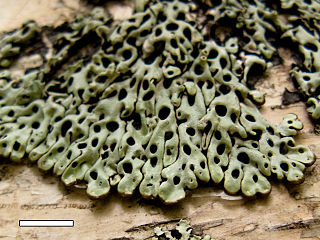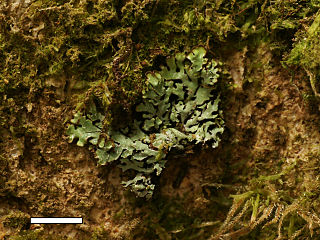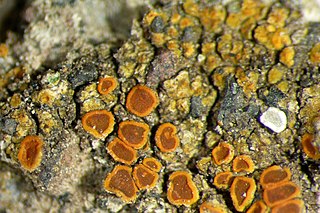
Menegazzia is a genus of lichenized fungi containing roughly 70 accepted species. The group is sometimes referred to as the tree flutes, honeycombed lichens, or hole-punch lichens. The most obvious morphological feature of the genus is the distinctive perforations spread across the upper side of the thallus. This makes the group easy to recognise, even for those not particularly familiar with lichen identification.
Menegazzia albida is a species of foliose lichen from South America. It was originally described as Parmelia cincinnata var. albida by Austrian botanist Alexander Zahlbruckner in 1917.
Menegazzia aucklandica is a species of foliose lichen from New Zealand. It was described as new to science by David Galloway and Peter James in 1983.
Menegazzia caliginosa is a species of foliose lichen from New Zealand, Australia and South America.

Menegazzia castanea is a species of foliose lichen from New Zealand and Australia.
Menegazzia dielsii is a species of foliose lichen from New Zealand. It was first formally described by German lichenologist Johannes Hillmann in 1940. Rolf Santesson transferred it to the genus Menegazzia in 1943. It contains several lichen products: atranorin, conpsoromic acid, echinocarpic acid, and psoromic acid.

Menegazzia eperforata is a species of foliose lichen found in New Zealand and Australia.
Menegazzia foraminulosa is a species of corticolous (bark-dwelling), foliose lichen that is endemic to New Zealand. The lichen was first formally described as a new species in 1876 by August von Krempelhuber. Friedrich Bitter transferred it to the genus Menegazzia in 1901. The species contains several lichen products, including depsides, depsidones, as well as fatty acids and pigments.
Menegazzia inflata is a species of foliose lichen found in New Zealand. Originally described as a species of Parmelia in 1940, it was transferred to the genus Menegazzia in 1983.
Menegazzia lucens is a species of foliose lichen from New Zealand.
Menegazzia neozelandica is a species of foliose lichen from New Zealand, Australia, and South America. It was first described by Austrian botanist Alexander Zahlbruckner in 1929 as Parmelia neozelandica. Peter James transferred it to the genus Menegazzia in 1992.

Menegazzia pertransita is a species of foliose lichen in the large lichen family Parmeliaceae. It is found in New Zealand, Australia, and South America. The lichen was first formally described by Scottish physician and bryologist James Stirton in 1877 as Parmelia pertransita. Swedish lichenologist Rolf Santesson transferred it to the genus Menegazzia in 1942.
Menegazzia pulchra is a species of foliose lichen found in New Zealand.
Menegazzia stirtonii is a species of foliose lichen found in New Zealand, and Tasmania, Australia.
Menegazzia subpertusa is a species of foliose lichen found in New Zealand, Australia, and South America.

Menegazzia testacea is a species of lichen found in New Zealand and Australia.
Menegazzia ultralucens is a species of lichen found in New Zealand and Australia.
Menegazzia weindorferi is a species of foliose lichen found in Australia. It was originally described by Austrian botanist Alexander Zahlbruckner as a species of Parmelia in 1907. Rolf Santesson transferred it to Menegazzia in 1942.

Caloplaca allanii is a species of saxicolous (rock-dwelling) and crustose lichen in the family Teloschistaceae. Found in New Zealand, it was formally described as a new species by Alexander Zahlbruckner. The type specimen was collected by Lucy Cranwell on Anawhata Beach in 1932; she sent a dried specimen to Zahlbruckner for identification. The specific epithet allanii honours New Zealand botanist Harry Allan.

Pertusaria allanii is a species of saxicolous (rock-dwelling) and crustose lichen in the family Pertusariaceae. Found in New Zealand, it was scientifically described as a new species in 1941 by Austrian-Hungarian lichenologist Alexander Zahlbruckner. The type specimen was collected from Waiheke Island, where it was found growing on coastal rock. The specific epithet allanii honours the collector, New Zealand botanist Harry Allan. As of 2018, in the New Zealand Threat Classification System, the lichen is considered "At Risk – Naturally Uncommon".






